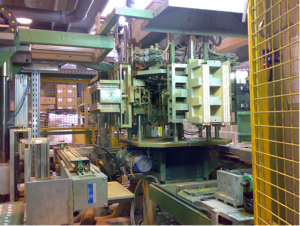
COS TRACTION ELEMENTS MOD. 2P8N-2T
The machine has the purpose to weld together the positive flags of one plate group in order to create the positive pole of the element and, analogously, also for the negative flags. C.O.S. machine is configured in the following way:
1. Pack automatic loading unit: a manipulator moved by a brushless motor pushes the pack into a pliers moved by pneumatic actuators. A series of shafts and bearings allows the pack to place itself into a special table positioned on a rotating central group where the pack is blocked by a pneumatic screwier with couple control.
2. Unit of brushing, fluxing and tinning: before proceeding to fusion, it is necessary to clean the flags by a metallic brushing and subsequently to distribute a pickle product on the flags. The treated flags are subsequently tinned by dipping them into a special tank contained inside the oven. The tank is connected to a pump that suctions the tin from the oven, and pumps it inside the same tank. The tin, in this way, exits from the tank and returns in the oven. This operation is carried out to keep a constant level of the tin, and to avoid the presence of scraps where the flags are dipped.
3. Fusion unit: the lead is melted inside a crucible (capacity 2 ton) and completed with two methane burners of 30000 Kcal for each. The lead bars are introduced into the crucible by a slide and the lead temperature is adjustable by operator panel and checked by a thermocouple. A centrifugal pump, made of cast iron and completed with a collector, pumps the lead from the crucible to the mould. In the collector, there are two resistances that keep the lead temperature constant during the transfer. The mould has a central body, kept up a constant temperature previously set. The mould is connected to a collector by a flexible hose with fast hooking to easily engage in the mould. The lead flows inside the channels and, during the transfer, exits through the special passages and it enters the little mould of element poles. A special cooling collector, with adjustable water capacity, allows the cooling of the mould and, when it is completely cooled, the extractor table lifts extracting the form of the pole from the mould.
4. Unloading unit and inserting in the box: optional pre-heat
5. Unloading unit of complete element: A pneumatic pusher pushes the pack in the relative vessel.
6. Verticalisation vessel unit: The conveyor near the reversing conveyor, that has the purpose to feed the last one, allows storing 20 boxes.
7. Chiller (optional): it has the purpose to cool the water of the mould
8. Electrical panel: it has PLC Siemens S7 and interface operator panel for management of the C.O.S. machine.
Technical features:
Sizes of machine: 4600 mm (length) x 4200 mm (width) x 2900 mm (height)
Weight of machine: about 6500 Kg
Sizes of plates to work: length from 220 to 620 mm; width from 145 to 190 mm
Productivity: from /2 to /8 positive plates machine produces N° 2 groups per minute from /9 to /12 positive plates machine produces N° 1 group per minute
Voltage: 380V + neutral—50 Hz
